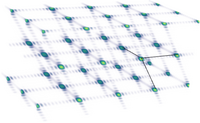Reciprocal space

Ok, buddy, have you ever played with a slinky? Imagine stretching out the slinky and looking at it from the side. You can see the big, wide gaps between the coils of the slinky, right? Now imagine that each one of those gaps represents something called "reciprocal space."
So, what is reciprocal space? It's a way of looking at things like crystals or other things that have a repeating pattern. When you look at the crystal through a microscope, you see a bunch of dots or spots, right? Those spots are actually a pattern that shows up when scientists use something called X-ray crystallography. They use this pattern to figure out the structure of the crystal.
But here's the thing: the pattern you see isn't just a bunch of random dots. It's actually related to something called "real space," which is the actual physical space that the crystal is in. Think of it like this: if you're looking at a map of your town, you can see all the different streets and buildings and parks, right? But if you zoom in really closely, you can see all the individual parts that make up those bigger things.
Reciprocal space is kind of like zooming in on a map. Instead of looking at the actual physical space the crystal is in, scientists look at the pattern of dots that shows up when they shine X-rays on it. They can use this pattern to figure out what the crystal is made of and how the atoms are arranged.
So, to sum it up: reciprocal space is like a pattern that shows up when scientists use X-ray crystallography to study a crystal. This pattern is related to the physical space the crystal is in, but it's kind of like zooming in on a map to look at the individual parts that make up the whole thing. Pretty cool, huh?
So, what is reciprocal space? It's a way of looking at things like crystals or other things that have a repeating pattern. When you look at the crystal through a microscope, you see a bunch of dots or spots, right? Those spots are actually a pattern that shows up when scientists use something called X-ray crystallography. They use this pattern to figure out the structure of the crystal.
But here's the thing: the pattern you see isn't just a bunch of random dots. It's actually related to something called "real space," which is the actual physical space that the crystal is in. Think of it like this: if you're looking at a map of your town, you can see all the different streets and buildings and parks, right? But if you zoom in really closely, you can see all the individual parts that make up those bigger things.
Reciprocal space is kind of like zooming in on a map. Instead of looking at the actual physical space the crystal is in, scientists look at the pattern of dots that shows up when they shine X-rays on it. They can use this pattern to figure out what the crystal is made of and how the atoms are arranged.
So, to sum it up: reciprocal space is like a pattern that shows up when scientists use X-ray crystallography to study a crystal. This pattern is related to the physical space the crystal is in, but it's kind of like zooming in on a map to look at the individual parts that make up the whole thing. Pretty cool, huh?
Related topics others have asked about:
